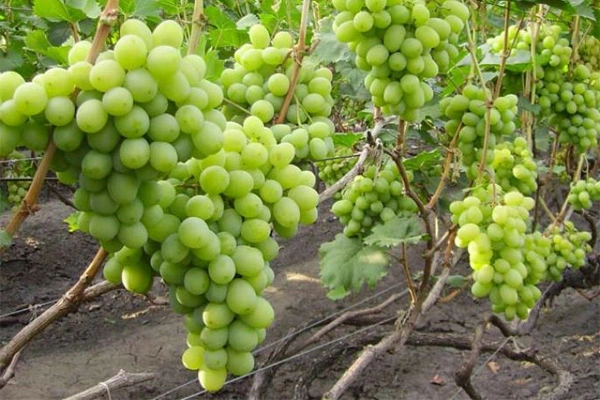“Gift to Zaporizhzhia” and all winegrowers – fans of table varieties – were prepared by amateur breeders of the “Grape Elite”, in particular Eugene Klyuchikov.
This hybrid is a mixture of the famous “Talisman” (the basis for many new varieties) and pollen of grape forms V-70-90 and R-65. The author set himself the goal not so much to improve the taste and aesthetic qualities of grapes, but to produce a more frost-resistant variety and not prone to disease. Therefore, bunches of “Gift to Zaporizhzhia” lose a little to many varieties in appearance, berries are less sweet, often green even after ripening, are slightly watery, but resistant to various adverse conditions.
General characteristics of grape varieties
Bunches in the “Gift of Zaporizhzhia” are quite large, an average of 900 g, and up to 2 kg. The berries have an apple flavor, the skin is thin but strong. In grapes 1-3 stones.
The variety is very well preserved (including on bushes) and transported.
Medium early, ripens in late summer. High-yielding, from a large bush you can collect 30 kg of grapes. Frost resistance is high – up to -24 degrees.
Does not need shelter for the winter.
Growing grapes
Grapes “Gift to Zaporizhzhia” are grown in dry, warm, sheltered from the wind places. The soil is suitable for any, well-drained.
Drainage (up to 25 cm) and soil mixture (garden soil, sand, peat, humus) are poured into the prepared pit 70–100 cm deep. The seedling is tied to a support, abundantly watered, then – only during drought. The best time for planting is spring.
In “Gift of Zaporizhzhia” female type of flowering. Therefore, in order not to have problems with artificial pollination by hand, this grape should be planted next to other varieties for cross-pollination.
In the first year the plant is not pruned until the following autumn. Then it is pruned every year in autumn. At active growth superfluous shoots, and then inflorescences pinch (it is desirable to do it when grape shoots are still young, the strengthened branches badly break off).
In spring, the grapes are fertilized with complex mineral fertilizers. For higher yields, growth stimulant is sprayed with gibberellin.
The soil is mulched.
The variety is so resistant to diseases that it is possible to treat against diseases only for prevention in rainy years.
Already in the second-third year the bush begins to bear fruit.

